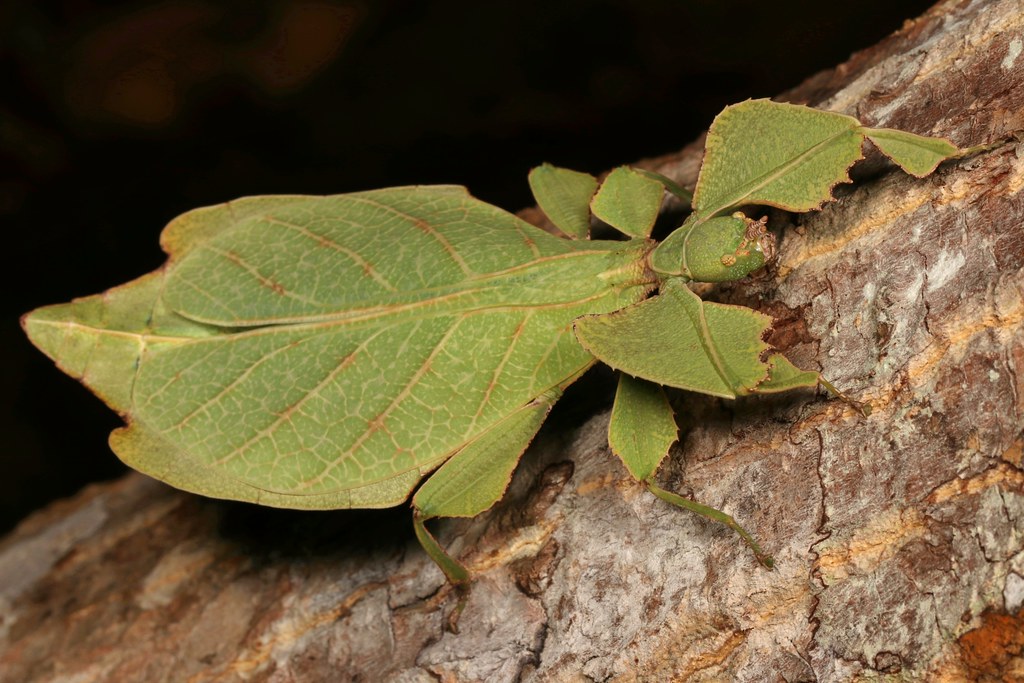Leaf insects need a heated, humid environment. This can be achieved using a heating pad and by spraying their enclosure with water several times a week. You should always have a thermostat and hygrometer installed to ensure these conditions don’t become too extreme.
Contents
Looking after a leaf insect
Do leaf insects need heat?
Types of leaf insect
Looking after a leaf insect
Most leaf insect species are very quiet during the day. They can be held, but are usually kept only to be observed sitting camouflaged on the branches of their tank. They become active at night, exploring their enclosure and feeding on leaves. Some leaf insect species can fly.

Leaf insects must be fed fresh leaves. They prefer bramble leaves, but they can also be fed oak and rose, and sometimes strawberry guava leaves. These are fairly easy to find and collect in the countryside, or can be collected from your own garden. Bramble leaves are handy as they are evergreen, so can be collected no matter the season.

One disadvantage of getting a leaf insect is you may have difficulties when trying to purchase one. Since they only live for a few months after reaching maturity, they aren’t typically kept in pet shops, so you’ll have to buy directly from a breeder. This may involve a long journey, or the insect may have to be shipped directly to your home, which is fairly risky.
Do leaf insects need heat?
Since leaf insects are native to hot environments, they need to be kept at a constant warm temperature. This varies between specific species of leaf insect, but generally they need a temperature between 25 and 30 degrees Celsius. This means a heat mat is recommended to make sure the temperature is warm enough for them. Always make sure to purchase a heat mat with a thermostat, so that the leaf insect can be kept safe if the mat overheats.

As well as high temperature, leaf insects need a high humidity, especially when they are still nymphs. This can be achieved with a typical house plant mister, which should be used several times a week. Make sure to never directly spray your insect though! This allows them to drink from the small droplets that will collect. Make sure to check for mold as it can easily collect in the hot and humid environment.

Lastly, leaf insects need a lot of ventilation. If you keep your insects in a plastic critter cage, replace the lid with a layer of mesh to allow air to circulate.
Types of leaf insect
There are over 30 different species of leaf insect, all with slightly different camouflage, so you have plenty of choice when it comes to the look of your pet.
Phyllium sp. is the most common species of leaf insect, a species which comes from tropical forest in the Philippines. It is probably most popular due to its bright green colouration, with veins to look exactly like a leaf in spring.

Another choice to make when keeping a leaf insect is whether to have a male or female. In some species, there is no significant difference between the two. However, in most species, such as Phyllium sp., the females are much larger, and only the males are able to fly.
Animal-Club provides animal parties or animal handling workshop where your will be able to see, learn and interact with the insects and other wonderful animals with the help of our presenters. Our mobile zoo has many friendly animals such as rabbits, tarantulas, geckos, vinegaroons and more that will be perfect for an animal party. We can also come over to your school for an animal school visit or arrange for an animal workshop with us where the children can learn about animals and have fun too.



